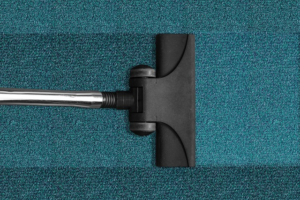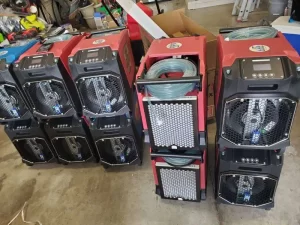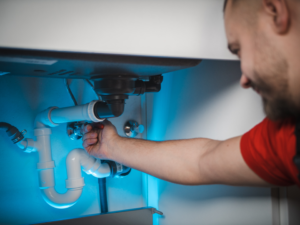Water damage can be devastating for homeowners and businesses, causing significant disruptions and potential harm to the property. In a city like Nashville, TN, where weather patterns can be unpredictable, it’s essential to know the right steps to take after water damage occurs, especially if the damage is extensive and you will need the services of a restoration company like Flood Kings. By acting swiftly and efficiently, you can protect your property, mitigate further damage, and promptly begin restoration.
This comprehensive guide will walk you through the crucial steps of a repair process after experiencing water damage in Nashville, TN.
Classifications of Water Damage
Before you start thinking about the drying process and how to repair the damage in your home, you should know that there are three classifications of water damage. These categories differentiate between the cleanliness of the water that caused the disaster in your home.
Clear Water
This type of water damage is the least dangerous for exposure. There are few to zero contaminants in the water, making it safe to deal with. Sources of clear water could be a leaky pipe or poor window insulation.
Grey Water
Grey water is the second classification and it contains somewhat dangerous contaminants. Sources of grey water in a home or business property could be a clogged shower drain, dishwasher leak, or flooding from a storm.
Black Water
The most dangerous classification of water damage is black water. This is water that has very dangerous chemicals and should not come into contact with the skin if possible. Sewer backup is often the source of black water damage.
These classifications are referred to as “categories” by water damage professionals. Black water, which is category 3 requires PPE and specialized equipment. If you are dealing with unsanitary water, calling in a service is advisable.
If the water looks clean and sanitary, the follow step can be followed.
The Steps
Ensure Safety First:
The safety of yourself and your loved ones should be the top priority. Water damage can create hazardous conditions, such as slippery surfaces and potential electrical hazards. If the water damage is extensive or poses any safety concerns, evacuating the premises is crucial until it’s deemed safe to re-enter. Remember, water and electricity can be lethal, so exercise caution. If you aren’t sure about the safety of the area, contact our emergency services right away.
Shut Off the Power
Electricity and water are a horrible mixture. Shocks are common injuries when water damage in your home comes into contact with power outlets or wiring. If possible, shut off the power to the area where the collected water is located. This may require you to access the circuit breaker, but only if it is not in contact with the water itself.
Wear Protective Gear
Electric shocks are not the only danger to those who are dealing with water damage repair. Depending on the source of the damage on your property, the water could be full of contaminants that are dangerous to your skin or open wounds. Protective clothes, waterproof boots, gloves, and other safety precautions can protect your skin when cleaning up sewage or other forms of contaminated water.
Contact a Professional Restoration
Restoration to damage caused by water requires specialized knowledge, equipment, and expertise. It’s advisable to contact a reputable restoration company in Nashville, TN, that specializes in water destruction cleanup and restoration.
They will have the experience and resources to handle the situation effectively. A professional service can assess the damage, provide an accurate estimate, and guide you through restoration.
While it may be tempting to proceed with a DIY repair operation, the cost of doing things incorrectly could be far greater than the money saved on professional services.
Stop the Source of Water:
Identifying and stopping the water source should be one of your immediate actions. If the water deterioration is caused by a burst pipe, a leaking appliance, or any other identifiable source, try to stop the water flow. Locate the main water valve in your property and turn it off to prevent additional damage.
Knowing where the different valves are in your home is crucial. After all, dealing with leaking appliances shouldn’t force you to shut off water to the entire house to handle. Know where the main shutoff valve is located. The hot water valve that is connected to your heater is also important to know about. Additionally, there are other valves located throughout the home, such as in the bathrooms or below the kitchen sink.
If you are familiar with the pipes and valves in your home, it will be easier to stop the source of water damage so you can get started on drying out the affected room and returning the space to its pre-loss condition.
Document the Damage:
Before you start any cleanup or restoration efforts, thoroughly document the extent of the damage caused by the water. Take photographs or videos of the affected areas, furniture, and personal belongings. This documentation will be invaluable for insurance claims and restoration purposes. When you work with Flood Kings, we will help with this documentation throughout the project.
Ensure capture of the overall scene and close-up shots of individual items or areas to provide a comprehensive visual record. Also, be sure to keep all receipts involved in the cleanup process, whether it involves buying supplies or paying for professional services. You can also keep any samples that are taken of the waters that caused the damage.
Confirming Coverage
One of the main reasons to document the structural damage and the affected area is to make it easier to confirm coverage with your insurance company. The more data you provide them, the easier it will be to submit your claim to cover the cost of repair.
Consult with the Insurance Company:
Contact your flood insurance provider immediately to report the water corruption incident. Provide them with the necessary documentation, including the photographs and videos you captured earlier. Follow their instructions for filing an insurance claim and provide any additional information they may require.
An insurance adjuster will assess the damage and guide you through the claims process. Your best chance to receive coverage for your ruined belongings and the cost of restoration is to provide plenty of documentation of the damage and to know what type of flood insurance your policy includes.
Remove Standing Water:
If it is safe, start removing water from your property. This water can cause additional damage to structures, flooring, and belongings. Use buckets, mops, or wet/dry vacuums to extract as much water as possible. Open windows and doors to promote airflow and aid in the drying process.
Sump Pump
A submersible pump is designed to make the water damage removal process faster. Many homes and businesses have sump pumps installed in the basements or lower levels that automatically kick in when the water activates the pumps. If your pump fails, is unable to keep up with the collection of water, or you do not have one, professional moisture removal services can use advanced pumping equipment to extract water from the property.
Remember to prioritize safety and avoid electrical hazards when removing water.
Salvage Important Belongings:
While removing standing water, prioritize salvaging important belongings, such as documents, electronics, and sentimental items. Place them in a safe, dry area to prevent future damage. Take extra care with delicate or valuable items.
If they are saturated, consult with restoration professionals who may be able to salvage them using specialized techniques.
Dry and Dehumidify:
After removing standing water, it’s crucial to dry the affected spaces thoroughly. Moisture can quickly lead to mold growth, causing additional damage and health concerns. Use fans, dehumidifiers, and proper ventilation to facilitate the drying process.
Direct airflow towards damper areas and consider using dehumidifiers to reduce moisture levels. Monitor the drying progress regularly and make adjustments as needed.
Air Movers and Dehumidifiers
Since airflow is crucial to dry out a wet space, you will want to use air movers, fans, and dehumidifiers liberally. Moving air can help evaporate water droplets out of the surfaces in the room and into the air where it can be extracted by the dehumidifiers.
Open Vs Closed System
There are two main methods for dealing with wet floors, walls, and rooms. An open drying system involves opening up the windows or doors of the space to allow natural airflow to occur.
A closed system is when everything is sealed up and various drying tools are used like air movers and large fans. A closed system is ideal if it is a humid or rainy day outside, as that environment would not be conducive to the drying process.
Dispose of Damaged Materials:
Items severely damaged or contaminated beyond repair should be safely disposed of. This includes waterlogged carpets, furniture, and any porous materials that could pose health risks. Properly discard these items according to local regulations. Consult with your restoration professionals for guidance on appropriate disposal methods.
Clean and Disinfect:
Thoroughly clean and disinfect all surfaces and belongings affected by damage from water. Use appropriate cleaning agents and disinfectants to prevent bacteria or mold development. Pay close attention to areas in contact with the water, including walls, floors, and furniture. Follow industry best practices and recommendations for effective cleaning and disinfection.
Tips for Effective Cleaning/Disinfecting
Sufficiently cleaning and disinfecting as quickly as possible is the best way to return to normalcy. Lift furniture and clean the bottoms or place tin foil on the legs to protect both the furniture and your floors during cleaning.
Use warm, soapy water for surfaces like countertops, floors, shelves, pots, and pans. You can disinfect them further if you desire.
Create a cleaning solution with a gallon of warm water and 3/4 cup of chlorine bleach. This cleaning agent can be used to scrub wet carpeting areas and other wet spots to prevent bacteria from collecting where the moisture is. Allow these items to air dry.
Whenever you are using bleach to get rid of health risks, make sure you keep the area well-ventilated by opening windows, as the fumes could be dangerous.
Wipe down walls and ceilings with a cleaning solution as well to remove bacteria.
Monitor for Mold Growth and Future Damage:
Even after completing the initial cleanup and restoration steps, it’s important to remain vigilant. Look for signs of mold growth, such as musty odors or visible mold. If you notice any indications of mold or additional damage, contact your restoration contractors immediately for further evaluation and mold remediation.
Signs of Water Damage to Monitor
Even the most thorough water damage restoration job may not get every drop of moisture out of your home. This is why it is so important to monitor the situation closely after restoration is complete to ensure that the problem was eliminated.
One of the most important steps to take after water damage is to watch for the signs of moisture problems after restoration.
Discolorations or Stains
Water that has been absorbed into materials often collects bacteria and rots the materials it is in contact with. This can result in brown stains or discolorations along the walls, ceilings, floors, and other surfaces. If you notice these stains, the source of the original water damage may not have been eliminated.
Musty Smells
Bacteria-filled water can often cause a musty odor to permeate the affected room or even the whole building. If you start to notice a funny smell in the days or weeks after the initial incident, it is possible that more water damage is occurring.
Peeling Paint
Paint is often the first structural element that displays the effects of water damage. Bubbling, peeling, or flaking might be signs that there is moisture nearby, so take note of the surrounding area and inspect it for water.
Sagging/Cracks in the Walls or Ceilings
Water compromises building materials and causes structural issues. The visible signs of this issue include cracks in the walls/ceilings and sagging walls/ceilings. Not only will you need structural repairs, but you will need to find and mitigate the source of the water damage that is causing the issue.
Visible Mold
While steps may have been taken to mitigate mold and mildew during the initial moisture removal process, mold spores require moisture to grow. That means if your home develops a water problem, or the initial source was never dealt with, mold could develop in the future. If you notice visible mold, then you should contact a water damage restoration contracting service to deal with the mold.
The Consequences of Doing Nothing
The biggest mistake that you can make when dealing with water damage is ignoring the problem or having a delayed response. Time is something that you cannot afford to lose, especially if you want your homeowners insurance to cover some of the costs.
But the greatest risk of not responding quickly and effectively is costly repairs down the road. The longer various materials and possessions in the property are exposed to water, the weaker they can become. Eventually, that small amount of damage can turn into extensive damage that results in a collapsed roof or completely rotted drywall.
If you don’t start dealing with the problem right away, then you will likely end up spending far more money on extensive repairs in the years to come. Water removal should be carried out as quickly as possible to prevent damage that will be done to your bank account in the future.
When You Are Overwhelmed by Water Removal Needs, Contact an Experienced Water Damage Restoration Company
In conclusion, experiencing damage from water in Nashville, TN requires prompt and strategic action. Following the comprehensive steps outlined in this guide, you can protect your property, mitigate additional harm, and begin the recovery steps effectively. Remember, time is of the essence when dealing with water destruction. Taking immediate action and enlisting professional help will greatly increase the chances of efficiently minimizing future damage and restoring your property.
If you’re unsure or overwhelmed, don’t hesitate to seek professional assistance from a reputable and professional restoration contractor in Nashville, TN. They have the expertise, experience, and resources to guide you through the process and ensure the best possible outcome for your property.
Plus, top-notch industry equipment ensures that your water damage recovery needs will be met.








